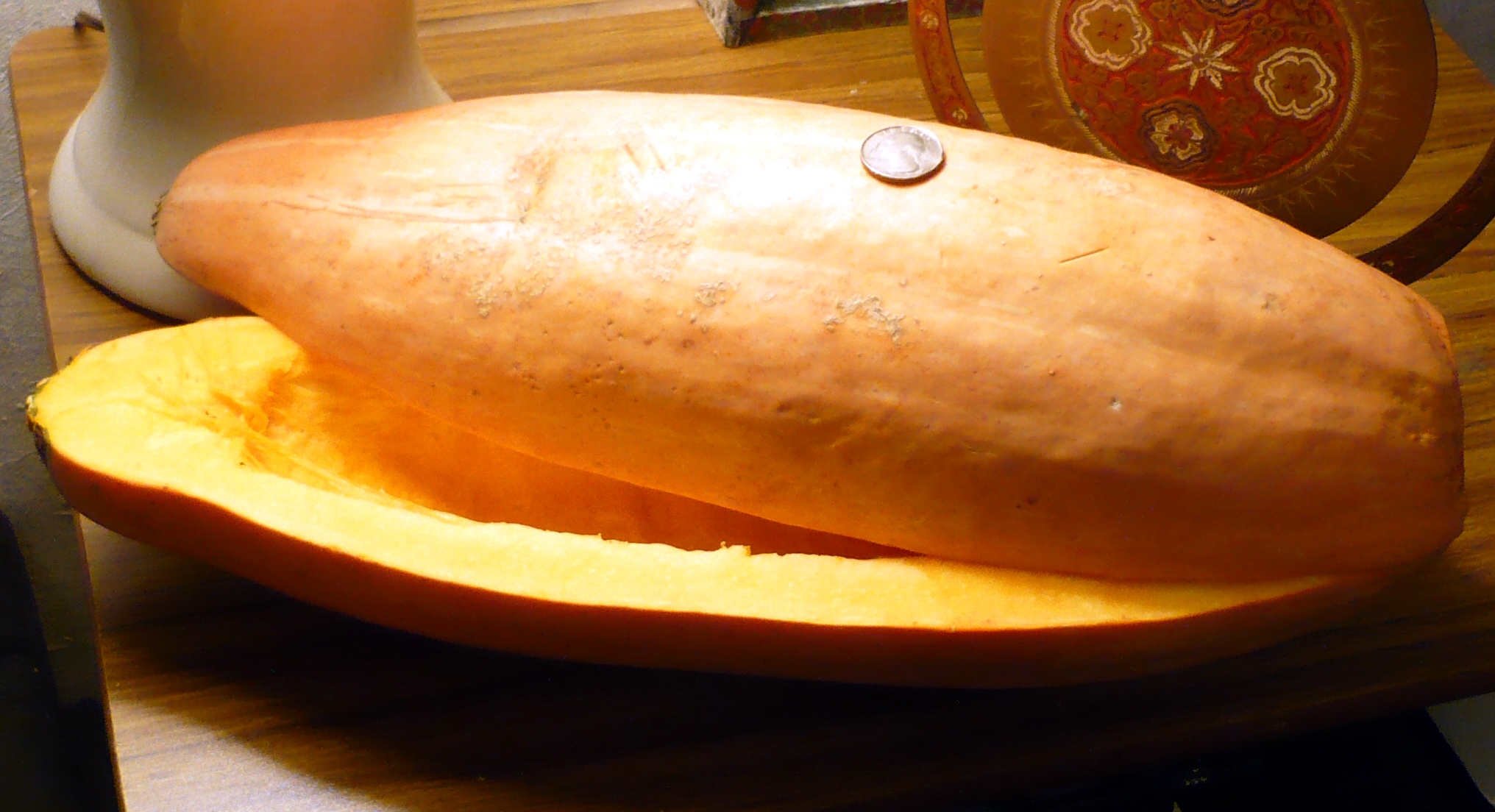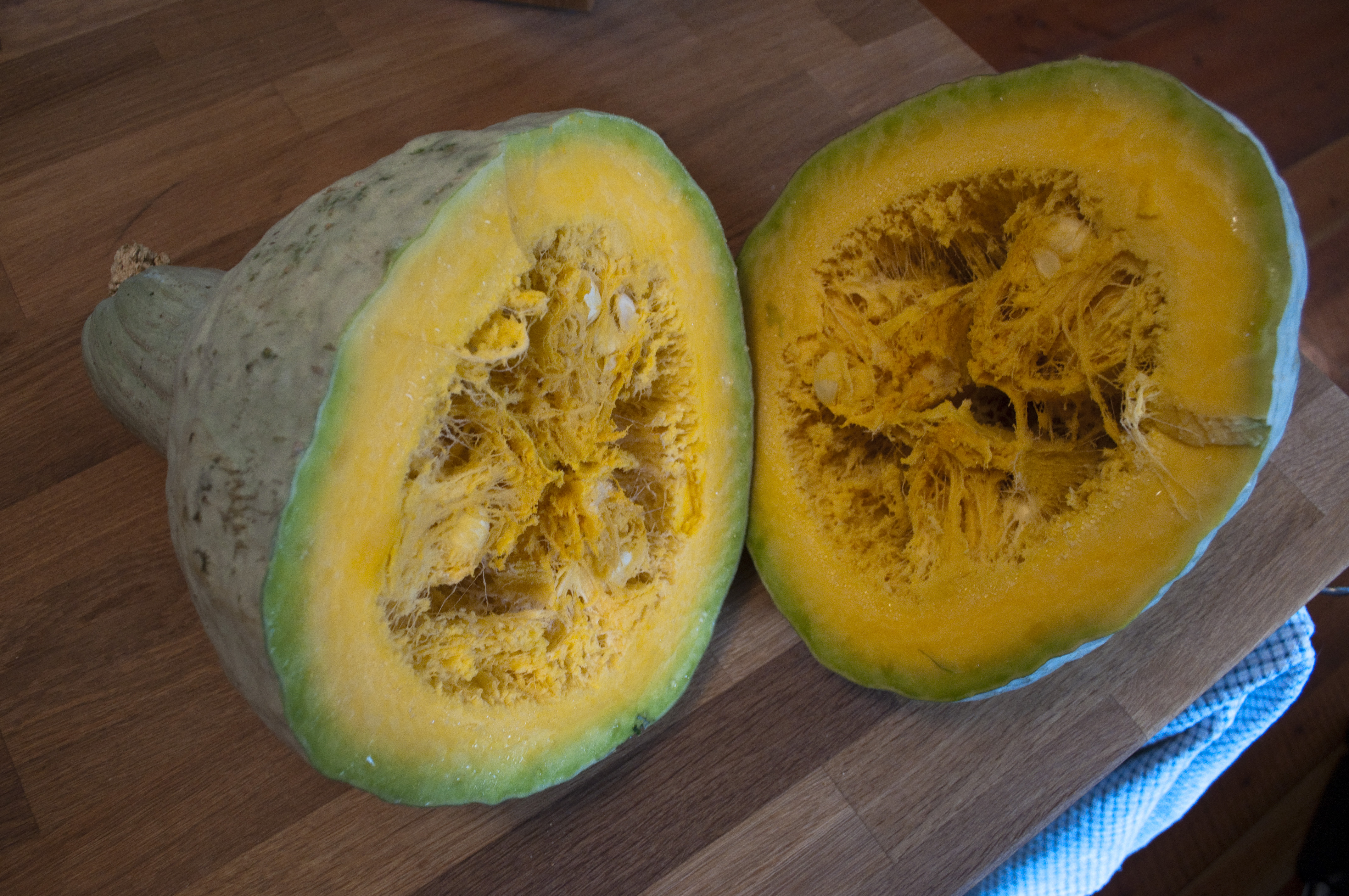Hubbard Squash on:
[Wikipedia]
[Google]
[Amazon]
''Cucurbita maxima'', one of at least five species of cultivated squash, is one of the most diverse domesticated species. This species originated in South America from the wild subspecies ''Cucurbita maxima subsp. andreana'' over 4,000 years ago. ''Cucurbita maxima'', known for modern varieties as Hubbard, Delicious, Marblehead, Boston Marrow, and Turks Turban, originated in northern Argentina near the Andes or in certain Andean valleys. Secondary centers of diversity include
 At one time considered a separate species, ''andreana'' has been placed by modern biosystematics as a subspecies of ''C. maxima''. It is native to
At one time considered a separate species, ''andreana'' has been placed by modern biosystematics as a subspecies of ''C. maxima''. It is native to



 *Arikara squash is an heirloom variety of ''C. maxima''. Fruits weigh from four to eleven pounds. The shape of the fruit can be tear-drop or round, and they are colored in a mottled orange and green pattern. It is desired both for its eating qualities and as a seasonal decoration. This variety traces its ancestry to the Arikara tribe of the Dakotas, among whom its cultivation predates white settlement.
*Banana squash has an elongated shape, with light blue, pink or orange skin and bright orange flesh.
*Boston marrow sweet tasting, narrow at one end and bulbous at the other.
*Buttercup squash is a common variety, with a turban shape (a flattish top) and dark green skin, weighing three to five pounds, and normally heavy with dense, yellow-orange flesh. Not to be confused with butternut squash.
*Candy Roaster squash is a landrace that was originally developed by the
*Arikara squash is an heirloom variety of ''C. maxima''. Fruits weigh from four to eleven pounds. The shape of the fruit can be tear-drop or round, and they are colored in a mottled orange and green pattern. It is desired both for its eating qualities and as a seasonal decoration. This variety traces its ancestry to the Arikara tribe of the Dakotas, among whom its cultivation predates white settlement.
*Banana squash has an elongated shape, with light blue, pink or orange skin and bright orange flesh.
*Boston marrow sweet tasting, narrow at one end and bulbous at the other.
*Buttercup squash is a common variety, with a turban shape (a flattish top) and dark green skin, weighing three to five pounds, and normally heavy with dense, yellow-orange flesh. Not to be confused with butternut squash.
*Candy Roaster squash is a landrace that was originally developed by the
File:Cucurbita maxima var. zapallito germplasm bank IPK code MAX 301 - 8 days after anthesis.jpg, Typical "Zapallito" summer squash fruit.
File:Cucurbita maxima Zapallo Plomo semillería Costanzi - 2014 03 28 - squash H I N P on the roof.JPG, A vining cultivar growing up to a roof.
File:Pumpkin plant @ Kanjirappally 02.jpg, Plant
India
India, officially the Republic of India (Hindi: ), is a country in South Asia. It is the seventh-largest country by area, the second-most populous country, and the most populous democracy in the world. Bounded by the Indian Ocean on the so ...
, Bangladesh
Bangladesh (}, ), officially the People's Republic of Bangladesh, is a country in South Asia. It is the eighth-most populous country in the world, with a population exceeding 165 million people in an area of . Bangladesh is among the mos ...
, Myanmar
Myanmar, ; UK pronunciations: US pronunciations incl. . Note: Wikipedia's IPA conventions require indicating /r/ even in British English although only some British English speakers pronounce r at the end of syllables. As John C. Wells, Joh ...
, and the southern Appalachians.
Different squash types of this species were introduced into North America as early as the 16th century. By the American Revolution, the species was in cultivation by Native American tribes throughout the present-day United States. By the early 19th century, at least three varieties are known to have been commercially introduced in North America from seeds obtained from Native Americans.
Types
Subspecies andreana
 At one time considered a separate species, ''andreana'' has been placed by modern biosystematics as a subspecies of ''C. maxima''. It is native to
At one time considered a separate species, ''andreana'' has been placed by modern biosystematics as a subspecies of ''C. maxima''. It is native to Argentina
Argentina (), officially the Argentine Republic ( es, link=no, República Argentina), is a country in the southern half of South America. Argentina covers an area of , making it the second-largest country in South America after Brazil, th ...
and Uruguay
Uruguay (; ), officially the Oriental Republic of Uruguay ( es, República Oriental del Uruguay), is a country in South America. It shares borders with Argentina to its west and southwest and Brazil to its north and northeast; while bordering ...
and is the ancestor of the domesticated forms. ''C. andreana'' fruits are smaller and not palatable. It hybridizes readily with individuals of other ''C. maxima'' subspecies.
''C. maxima subsp. andreana'' has notably different calcium
Calcium is a chemical element with the symbol Ca and atomic number 20. As an alkaline earth metal, calcium is a reactive metal that forms a dark oxide-nitride layer when exposed to air. Its physical and chemical properties are most similar to ...
levels than individuals of other ''C. maxima'' subspecies. ''C. andreana'' has yellow flowers and bright green striped fruit. Extrafloral nectaries
Nectar is a sugar-rich liquid produced by plants in glands called nectaries or nectarines, either within the flowers with which it attracts pollination, pollinating animals, or by extrafloral nectaries, which provide a nutrient source to anim ...
are present in ''C. maxima'' but not necessarily in ''C. andreana''.
It was first formally described by Charles Victor Naudin
Charles Victor Naudin (14 August 1815 in Autun – 19 March 1899 in Antibes) was a French naturalist and botanist.
Biography
Naudin studied at Bailleul-sur-Thérain in 1825, at Limoux, and at the University of Montpellier from which he gra ...
in 1896, in ''Revue Horticole''.
Cultivars


Cherokee
The Cherokee (; chr, ᎠᏂᏴᏫᏯᎢ, translit=Aniyvwiyaʔi or Anigiduwagi, or chr, ᏣᎳᎩ, links=no, translit=Tsalagi) are one of the indigenous peoples of the Southeastern Woodlands of the United States. Prior to the 18th century, t ...
people in the southern Appalachians. Another heirloom variety, it is quite variable in size (10-250+ lbs), shape (round, cylindrical, teardrop, blocky, etc.), and color (pink, tan, green, blue, gray, or orange), yet most have fine-textured, orange flesh. This variety enjoys continued popularity, particularly in the southern Appalachians.
*Hubbard squash is another cultivar
A cultivar is a type of cultivated plant that people have selected for desired traits and when propagated retain those traits. Methods used to propagate cultivars include: division, root and stem cuttings, offsets, grafting, tissue culture, ...
of this species that usually has a tear-drop shape. It is often used as a replacement for pumpkin
A pumpkin is a vernacular term for mature winter squash of species and varieties in the genus ''Cucurbita'' that has culinary and cultural significance but no agreed upon botanical or scientific meaning. The term ''pumpkin'' is sometimes use ...
s in cooking. According to one source, the name comes from Bela Hubbard, settler of Randolph Township, Ohio
Randolph Township is one of the eighteen townships of Portage County, Ohio, United States. The 2000 census found 5,504 people in the township.
Geography
Located in the southern part of the county, it borders the following townships:
* Rootstown ...
in the Connecticut Western Reserve. Many other sources list an alternate history. These sources state the hubbard squash (at the time nameless) came to Marblehead, Massachusetts
Marblehead is a coastal New England town in Essex County, Massachusetts, along the North Shore (Massachusetts), North Shore. Its population was 20,441 at the 2020 United States Census, 2020 census. The town lies on a small peninsula that extends ...
through Captain Knott Martin. A woman named Elizabeth Hubbard brought the fruit to the attention of her neighbor, a seed trader named James J. H. Gregory. Mr. Gregory subsequently introduced it to the market using Mrs. Hubbard's name as the eponym
An eponym is a person, a place, or a thing after whom or which someone or something is, or is believed to be, named. The adjectives which are derived from the word eponym include ''eponymous'' and ''eponymic''.
Usage of the word
The term ''epon ...
. Gregory later bred and released the blue hubbard, which has a bluish-gray skin. The other major variety, the golden hubbard squash, has a bright orange skin. Gregory advertisements for the squash date from at least 1859. The hubbard squash, including questions regarding the name, is even the subject of a children's ditty, "Raising Hubbard Squash in Vermont".
*Jarrahdale pumpkin
The Jarrahdale pumpkin is an heirloom variety of winter pumpkin bred in Australia
Australia, officially the Commonwealth of Australia, is a Sovereign state, sovereign country comprising the mainland of the Australia (continent), Australi ...
is a pumpkin with gray skin. It is nearly identical to 'Queensland Blue' and 'Sweet Meat' varieties.
* Kabocha is a Japanese variety with dark green skin and bright golden-orange flesh.
*Lakota squash is an American variety.
*Nanticoke squash is a rare heirloom variety that was traditionally grown by the Nanticoke people of Delaware and Eastern Maryland. It is one of only a few surviving Native American winter squashes from the Eastern woodlands.
*Turban squash
Turban squash, also known as "Turk's turban" or "French turban" (''"Giraumon"'' in French), is a type of squash most often used as a winter squash. It is an heirloom, predating 1820. A cultivar of ''Cucurbita maxima'', it is closely related to th ...
, also known as "French turban", an heirloom predating 1820, and closely related to the buttercup squash.
Uses
Buttercup squash, a common cultivar, can be roasted, baked, and mashed into soups, among a variety of filler uses, much likepumpkin
A pumpkin is a vernacular term for mature winter squash of species and varieties in the genus ''Cucurbita'' that has culinary and cultural significance but no agreed upon botanical or scientific meaning. The term ''pumpkin'' is sometimes use ...
. It is extremely popular, especially as a soup, in Brazil
Brazil ( pt, Brasil; ), officially the Federative Republic of Brazil (Portuguese: ), is the largest country in both South America and Latin America. At and with over 217 million people, Brazil is the world's fifth-largest country by area ...
, Colombia
Colombia (, ; ), officially the Republic of Colombia, is a country in South America with insular regions in North America—near Nicaragua's Caribbean coast—as well as in the Pacific Ocean. The Colombian mainland is bordered by the Car ...
, and Africa
Africa is the world's second-largest and second-most populous continent, after Asia in both cases. At about 30.3 million km2 (11.7 million square miles) including adjacent islands, it covers 6% of Earth's total surface area ...
.
All giant pumpkin
A giant pumpkin is an orange fruit of the squash '' Cucurbita maxima'', commonly weighing from to over .Karl, J. R. 2014. ''Cleaning the Giant Pumpkin''
History
Growing giant pumpkins emerged out of the North American agricultural traditio ...
s (over ) are of this species, including the largest pumpkins ever documented, which have attained a size of .
The seed of ''C. maxima'' is used in treating parasites in animals.
Cultivation
Since this plant requires a fair amount of hot weather for best growth, it has not become very well established in northern Europe, the British Isles, or in similar areas with short or cool summers. Many cultivars of ''Cucurbita maxima'' have been developed. Only long-vining plants are known in this species.Victor E. Boswell and Else Bostelmann. "Our Vegetable Travelers." ''The National Geographic Magazine.'' 96.2: August 1949. As in '' C. pepo'', plants exist with a "bush habit" that is particularly evident in young plants, but older plants grow in the wild-type vining manner.Gallery
References
External links
* * {{Authority control Squashes and pumpkins maxima